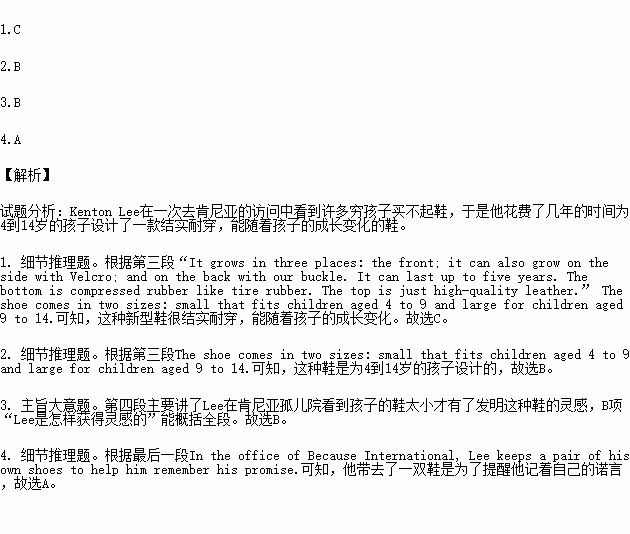题目内容
Children grow quickly, especially their feet, but many families cannot buy new shoes each time a child needs them. As a result, about 300 million children around the world go barefoot. Those children risk picking up diseases and parasites from the soil.
An American man may have a solution for those barefoot kids — a shoe that grows with the child. Kenton Lee is the creator of The Shoe That Grows. He explains how the shoe works and how it is able to last so long.
“It grows in three places: the front; it can also grow on the side with Velcro; and on the back with our buckle. It can last up to five years. The bottom is compressed rubber like tire rubber. The top is just high-quality leather.” The shoe comes in two sizes: small that fits children aged 4 to 9 and large for children aged 9 to 14.
Lee says he got the idea for the shoe while working as a volunteer in an orphanage in Kenya. “… and there was a little girl in a white dress walking next to me. And I just remember looking down and seeing how small her shoes were. They were just way too small for her feet. They were so small that she had to cut open the front of her shoes to let her toes stick out. And I just remember thinking, wouldn't it be nice if there were a pair of shoes that could grow with her feet?”
However, Lee says it was not easy to turn his idea into a reality. “I kept writing down I should do this because of this or because of that. All these reasons why it really was important for me to try to make the shoes that could grow and try to help.” Finally, in 2009 Lee founded a non-profit organization called Because International. In the office of Because International, Lee keeps a pair of his own shoes to help him remember his promise. “I told myself I would not get new shoes until the idea was done. So, those are the shoes that I wore for a little over five years.”
1.Which of the following is the characteristic of the newly invented shoes?
A. They are more expensive.
B. They are not so comfortable.
C. They can grow with a child.
D. They come in different sizes.
2.Who is this kind of newly invented shoes intended for?
A. All the teenagers.
B. Children aged 4 to 14.
C. Middle-aged women in Africa.
D. Senior citizens with low income.
3.What does Para. 4 mainly talk about?
A. How the shoes work.
B. How Lee got his inspiration.
C. How to make the new shoes.
D. Where to order this kind of shoes.
4.Why does Kenton Lee keep a pair of his own shoes in the office?
A. To remind him of his promise.
B. To copy the design of them.
C. To get a change conveniently.
D. To use them as an example.
假如你是李明,对今年频繁出现的严重雾霾感触很深,认为绿色生活方式对于改善空气质量十分有益。请根据下列要点写一篇短文,向校刊“英语角”栏目投稿。
注意:词数100左右;文章开头已给出,不计入总词数。
简述雾霾情况 | 倡导绿色生活 |
持续一周左右 影响全国各地 造成极大不便 | 乘坐公交出行 节约水电纸张 …… |
Greener Life, Cleaner Air
It is not easy to forget the heavy smogs that have occurred frequently this year. _______________________________________________________________________________
_______________________________________________________________________________
_______________________________________________________________________________
_______________________________________________________________________________
_______________________________________________________________________________
_______________________________________________________________________________
_______________________________________________________________________________
_______________________________________________________________________________
_______________________________________________________________________________
_______________________________________________________________________________


